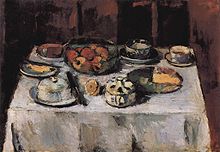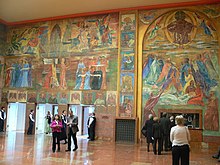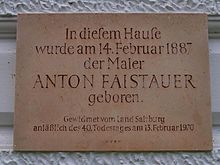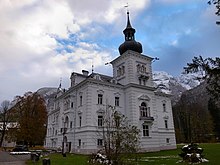Anton Faistauer
Anton Faistauer (born February 14, 1887 in Sankt Martin bei Lofer , ( Salzburg ), † February 13, 1930 in Vienna ) was an Austrian painter .
Life
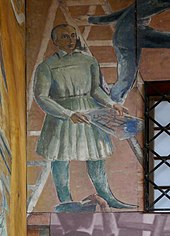
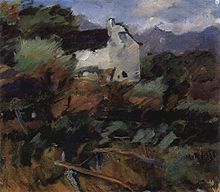
Anton Faistauer came from a farming family and originally wanted to become a clergyman. He spent a large part of his youth in Maishofen . During high school in Bozen he turned to painting, attended R. Scheffer's private painting school in Vienna from 1904 to 1906 and studied at the Academy of Fine Arts Vienna from 1906 to 1909 with Alois Delug and Christian Griepenkerl . Together with Anton Kolig , Robin Christian Andersen , who later became his brother-in-law, Franz Wiegele and Egon Schiele, he founded the new art group in 1909 in protest against the conservative art business . At the end of the summer semester of 1909 he left the academy. In the years between 1909 and 1912 he traveled to Ticino , Northern Italy and Berlin . In 1909 and 1910 the Neukunstgruppe exhibited for the first time in the Pisko art salon on Schwarzenbergplatz; further exhibitions followed in Budapest, Munich, Vienna ( Hagenbund ), Cologne, Dresden and Rome.
In 1913 Anton Faistauer married Ida Andersen, the sister of the painter Robin Christian Andersen . She gave birth to their son Peter. On October 1st, the first collective exhibition was opened in the Miethke Gallery in Vienna, which included 33 oil paintings and was very successful. In 1915 he moved to Maishofen due to the war . During the First World War, graduated Faistauer 1916-1918 military service, for the time being - because of unsuitability "unarmed" - in kuk - Infantry Regiment . No. 59, as of July 1917 at the Austro-Hungarian Army Museum "for special purposes". In the museum he organized exhibitions of war paintings together with Egon Schiele and was able to develop freely again artistically.
After the end of the war Faistauer was in Salzburg (from 1919), where he founded the radical artists' association “ Der Wassermann ” together with Felix A. Harta and others . His first wife died the night before the group's first major exhibition opened on August 3, 1919.
In 1921 he got a second marriage with Emilie Ehrenberger, three years later his second son Thomas was born. He took part in the spring and autumn exhibition of the Vienna Secession . In 1924 and 1925 he stayed several times in Bolzano to treat his stomach and lung ailments. In 1925 he took part in the international art exhibition in Zurich together with Oskar Kokoschka . After the second marriage failed, he lived with Adelgunde Krippel . He was commissioned to paint the Salzburg Festival Theater with frescoes . In 1927 the company moved to Vienna. Trips to Venice, Naples, Taormina, Palermo and Genoa followed; the vedute created on this trip in a “tragic tone” betrays an existential personality crisis.
In 1930 he suffered a gastric bleeding that required an operation. On February 13th, Anton Faistauer died of the consequences. Faistauer was buried in the Maishofen cemetery. The tomb was built according to a design by Clemens Holzmeister .
Recognitions
In 1914 Faistauer won first prize in the Reininghaus competition. In 1926 he was appointed professor. In 1987 the Austrian Post published a special postage stamp in honor of Faistauer's 100th birthday. In 2004 the Anton Faistauer Forum was founded, which is dedicated to the documentation, interpretation and presentation of Faistauer's work. From February 11 to May 22, 2005 a large special exhibition took place in the Salzburg Museum Carolino Augusteum. The Faistauergasse in Salzburg was named after Anton Faistauer , as well as the Faistauergasse in Vienna- Hietzing (since 1931) and the Anton Faistauer Prize .
plant
Faistauer is one of the most important painters of Austrian modernism. Before the First World War, the young artist became known through exhibitions in Germany (Anton Faistauer was also a member of the German Association of Artists ) and Budapest. In contrast to most of his colleagues, he tried to develop traditional occidental painting. In his book New Painting in Austria , published in 1923 , he dealt programmatically and at times extremely pointedly with the modernism of his time. He remarked on Gustav Klimt and Egon Schiele : “Klimt attracted the light, shallow monetary Jewry of the inner city and he became his painter; The suburbs weighed on Schiele with the tragic faces, with hunger, hatred and the grimace ”. Paul Cézanne's paintings were particularly important for Faistauer . In this book he also dealt with Franz Wiegele and Anton Kolig, the main representatives of the "Nötscher Kreis", with whom he had been in contact and corresponded since 1909. In addition to landscapes, still lifes and portraits, Faistauer created several large-format frescoes in the 1920s, which are now considered to be his main works. With them he tried to develop a contemporary fresco painting and to fuse modern with traditional elements. Interest in religious topics is also reflected in his work.
Most of Faistauer's paintings are in the Salzburg Museum Carolino Augusteum and the Museum der Moderne Rupertinum in Salzburg, but also in the State Museum in Linz, in the Lower Austrian State Museum in St. Pölten and in Vienna in the Leopold Museum and the Austrian Gallery. In Maishofen, where he was born, there are also a number of important works specifically related to the place.
Frescoes
- in the Morzg Church in Salzburg, 1922
- Mercy Seat of the Trinity and the miraculous image of Maria Plain on the facade of the St. Benedict College in Salzburg, 1926
- in the Salzburger Festspielhaus , 1926 (removed in 1938, transferred back to canvas today). In 40 days, Faistauer and his assistants had painted the foyer of the Salzburg Festival Hall, around 350 square meters with over 200 figures. This meant the international breakthrough.
- in the Ledererschlössel in Weidlingau near Vienna, 1929
Oil painting
- Alte Mühle bei Maishofen (Vienna, Leopold Museum , inv.no.370), 1911, oil on canvas, 41 × 46 cm
- Still life with coffee cups (Vienna, Leopold Museum, inv. No. 362), 1912, oil on canvas
- Seaside (Vienna, Leopold Museum, Inv. No. 359), 1912, oil on canvas
- Delphinium in a ceramic jug (Vienna, Leopold Museum, inv.no.520), 1913, oil on canvas, 68 × 42 cm
- Two female nudes (private property), 1913, oil on canvas, 141.5 × 117 cm
- Summer landscape (Linz, Castle Museum, Kastner donation, inv. No. Ka 27), oil on canvas, 67 × 79 cm
- Wachau Landscape (Vienna, Leopold Museum, Inv. No. 364), 1913, oil on canvas
- Road to Dürnstein (Vienna, Leopold Museum, Inv. No. 363), 1913, oil on canvas
- View of Dürnstein (St. Pölten, Niederösterreichisches Landesmuseum , inv. No. 3583), 1913, oil on canvas, 51.2 × 71.1 cm
- Woman on a red sofa - wife of the artist (Vienna, Österreichische Galerie Belvedere ), 1913, oil on canvas, 96 × 125 cm
- Forest Interior (Vienna, Leopold Museum, Inv. No. 361), 1914, oil on canvas
- Flower piece with apples (Vienna, Leopold Museum, inv. No. 360), 1914, oil on canvas
- Covered table (Vienna, Leopold Museum, inv.no.111), 1916, oil on canvas, 65.5 × 92.7 cm
- Lady with a Dark Hat (Vienna, Leopold Museum, inv.no.112), 1917, oil on canvas, 66.2 × 50.2 cm
- Roses in a white vase (Vienna, Leopold Museum, inv.no.621), 1917, oil on cardboard
- Portrait of a lady (Linz, Castle Museum, Kastner donation, inv. No. Ka 26), oil on panel, 54 × 43 cm
- Saint Martin - Study (Vienna, Leopold Museum, Inv. No. 356), 1918, oil on canvas
- Son Peter sitting (Vienna, Leopold Museum, inv. No. 110), 1918, oil on canvas
- Horsemen and marching column (Vienna, Museum of Military History ), 1918, oil on cardboard
- Portrait of Kathi Eder (Vienna, Leopold Museum, inv. No.358), 1919, oil on canvas
- Wife of the artist with wine glass (Vienna, Leopold Museum, inv. No. 1978), 1919, oil on canvas
- Heilige Margareta (Vienna, Leopold Museum, inv. No.620), 1923, oil on canvas
- Chamber singer Richard Mayr as Ochs von Lerchenau in "Rosenkavalier" by R. Strauss (Salzburg, Rupertinum), 1927
- Lady with evening dress - Gundl Krippel (Linz, Upper Austrian State Museum, inv.no.G 916), 1927, oil on canvas, 207 × 89 cm
Fonts
- New painting in Austria. Considerations of a painter. Amalthea, Vienna 1923.
Exhibitions (selection)
- 2005: Salzburg Museum : Anton Faistauer 1887–1930. Retrospective
literature
- Arthur Roessler : The painter Anton Faistauer. Contributions to the life and work history of an Austrian artist. Wiener Volksbuchverlag, Vienna 1947.
- Franz Fuhrmann : Anton Faistauer: 1887 - 1930. With a catalog raisonné of the paintings . Residenz-Verlag, Salzburg 1972, ISBN 3-7017-0028-0 .
- Wilhelm Baum (Hrsg.): Works of art are stations on the Passionsweg to a lost paradise. Letters and documents from the Nötscher district. 2nd Edition. Kitab-Verlag, Klagenfurt 2004, ISBN 3-902005-23-8 .
- Salzburg Museum Carolino Augusteum (Ed.): Anton Faistauer. 1887-1930. Catalog for the special exhibition of the Salzburg Museum Carolino Augusteum from February 11 to May 22, 2005. Salzburg 2005, ISBN 3-900088-11-X .
- Ilse Krumpöck: Anton Faistauer's military uselessness. (= Series of publications on Anton Faistauer and his time. Volume 2). Published by the Anton Faistauer Forum, Maishofen 2007, ISBN 978-3-9502420-0-3 , p. 15.
- Inge Höfer-Wegleiter: Faistauer, Anton. In: New German Biography (NDB). Volume 4, Duncker & Humblot, Berlin 1959, ISBN 3-428-00185-0 , p. 748 f. ( Digitized version ).
- Faistauer Anton. In: Austrian Biographical Lexicon 1815–1950 (ÖBL). Volume 1, Verlag der Österreichischen Akademie der Wissenschaften, Vienna 1957, p. 282.
Web links
- Literature by and about Anton Faistauer in the catalog of the German National Library
- Entry for Anton Faistauer in the database of the state's memory for the history of the state of Lower Austria ( Museum Niederösterreich )
- Entry on Anton Faistauer in the Austria Forum (in the AEIOU Austria Lexicon )
- Anton Faistauer Forum
- Page about Anton Faistauer on the Maishofen tourist office
- Article in the SalzburgerLand magazine about the 125th anniversary of the Maishofen community
- Salzburg Museum: Anton Faistauer 1887–1930 special exhibition in the SMCA main building, Museumsplatz 1, February 11 to May 22, 2005
Individual evidence
- ↑ Baptismal Register - TFBVIII | St. Martin near Lofer | Salzburg, rk. Diocese | Austria | Matricula Online. Retrieved October 31, 2018 .
- ↑ Ilse Krumpöck: Anton Faistauer's military uselessness. (= Series of publications on Anton Faistauer and his time. Volume 2). Published by the Anton Faistauer Forum. Maishofen 2007, p. 60.
- ↑ kuenstlerbund.de: Ordinary members of the German Association of Artists since it was founded in 1903 / Faistauer, Anton ( Memento from March 4, 2016 in the Internet Archive ) (accessed on July 28, 2015)
- ↑ Review in: Hermann Bahr : Love of the Living. Diaries 1921/23. Volume 2, Borgmeyer, Hildesheim 1925, pp. 264-270.
- ^ Anton Faistauer 1887–1930. Retrospective. Salzburg Museum , 2005.
| personal data | |
|---|---|
| SURNAME | Faistauer, Anton |
| BRIEF DESCRIPTION | Austrian painter |
| DATE OF BIRTH | February 14, 1887 |
| PLACE OF BIRTH | Saint Martin near Lofer |
| DATE OF DEATH | February 13, 1930 |
| Place of death | Vienna |
